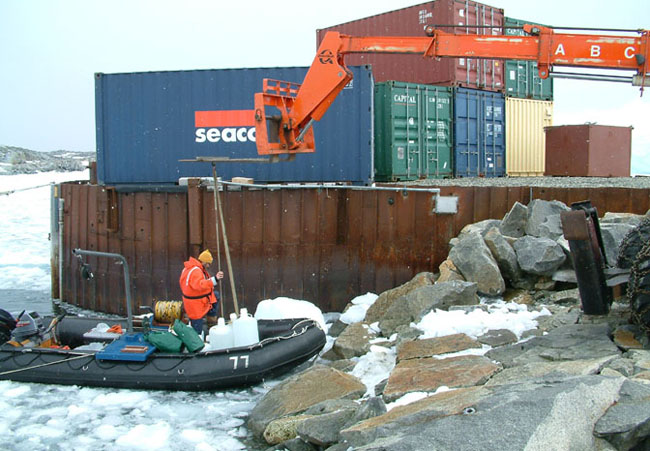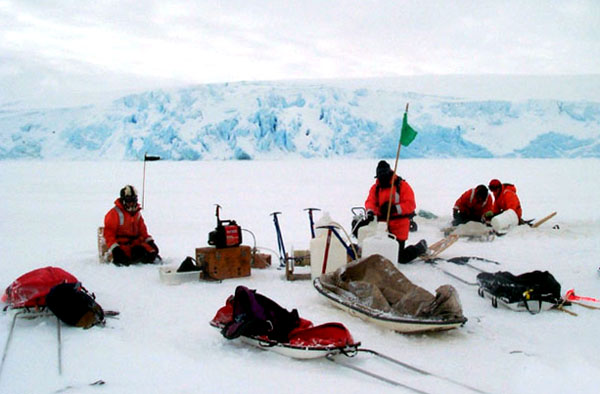|
Microbes one key component of carbon, nitrogen cycles in the oceanMore Information
Previous project Web site: GenEx2
In the spring and summer, bacteria are involved in an incredible amount of metabolic activity, decomposing organic matter produced through photosynthesis by phytoplankton, and turning it back into carbon dioxide. Without the recycling activities of bacteria and zooplankton, the bulk organic matter would sink into the deep ocean, isolating the CO2 from the atmosphere. “What’s opposing the sinking process is microbial respiration, which is turning the organic matter back into CO2 before it can sink out,” Ducklow explained. “Part of the system is trying to put it into the deep sea, while the other part is trying to burn it back out into the atmosphere. “Bacteria represent one of the most important compartments at the basis of all food webs in marine ecosystems,” said Jean-Francois Ghiglione, a researcher at the Institution Centre National de la Recherche Scientifique in Paris. He is one of the international collaborators for the IPY project at Palmer Station. “An estimated 20 to 50 percent of marine primary productivity is channeled through bacteria,” he added. “They respond clearly to environmental changes, and participate in all biogeochemical cycles. Therefore, they have many advantages to serve as a basis for any long-term oceanic observation systems.” The scientists also want to learn more about how archaea are involved, particularly in the carbon and nitrogen cycles. Archaea are single-celled microorganisms that “look” like bacteria, but are actually more closely related to complex, multi-cellular organisms such as plants. They were discovered in frigid coastal Antarctic waters by scientist Ed DeLong in 1994. In the mid-1990s, as a graduate student, Murray worked with DeLong at the University of California, Santa Barbara, doing some of the first molecular research on Southern Ocean microorganisms. “At the time, it was quite surprising to see them down there because we didn’t know their global distribution, and they were commonly thought to inhabit extremely hot, salty, and often anoxic [lacking oxygen] environments,” Murray said. Now they know archaea are one of the most abundant single-celled organisms in the oceans, their sheer biomass accounting for upwards of 40 percent of the cells in the deep ocean. However, distribution of archaea in the Southern Ocean is different from other marine environments, Murray said. “It’s one of the only places in the world where we find them in the surface waters.” 
Photo Credit: Alison Murray/GenEx2
A crane unloads water samples from an inflatable boat called a Zodiac.
Again, it appears to be a seasonal thing, as the archaea are found in the deeper parts of the ocean in the summer and inhabit the upper water column from late fall to early spring. “That gave us a clue that things really change down there seasonally,” Murray said. The seven-member science team will work from July through September collecting their samples and analyzing the organisms right at Palmer Station, including the genomic work. Ducklow’s graduate student Kristin Myers and technician Matthew Erickson also collected samples during this austral summer for comparison. Though their tools are innovative, there’s nothing too high-tech about how they collect the bacteria and archaea. The technique will depend largely on the condition of the sea ice in the winter. Open ocean means the team can use Zodiacs, inflatable boats, to collect samples. The presence of sea ice will require team members to ski to designated sites and drill holes through the ice to reach the water. “We have to be flexible because those conditions change at Palmer, and they’re not exactly predictable,” Murray said. The scientists use big carboys, similar to what a homebrewer uses to make beer, to collect seawater, which can contain about 200,000 cells per milliliter. The team will work in an environmentally controlled room at the station, where the temperature will be that of seawater, about minus 1.8 degrees Celsius. A filtration system squeezes out the water, leaving all the critters behind. “We get a kind of microbial soup,” Murray said. The researchers will share that soup, using samples for different purposes “to crack the door open on processes rarely studied in the high latitude waters of the Southern Ocean,” Murray said, as they describe genomic diversity, gene and protein expression between summer and winter, as well as investigate the survival adaptations of wintertime bacterioplankton. “It will be a busy day each time we go out,” she added. “You can’t quite understand the ecosystem ecology down there without having a seasonal perspective.” And given the international flavor of the project, the scientists expect to learn something about how different programs operate. “The IPY project is a wonderful opportunity to work together with our American colleagues, to share our experience, and get new insight on this extreme and very fragile environment,” Ghiglione said. NSF-funded research in this story: Alison Murray and Joe Grzymski, Desert Research Institute; and Hugh Ducklow, The Ecosystems Center at the Marine Biological Laboratory. |



For USAP Participants |
For The Public |
For Researchers and EducatorsContact UsU.S. National Science FoundationOffice of Polar Programs Geosciences Directorate 2415 Eisenhower Avenue, Suite W7100 Alexandria, VA 22314 Sign up for the NSF Office of Polar Programs newsletter and events. Feedback Form |


